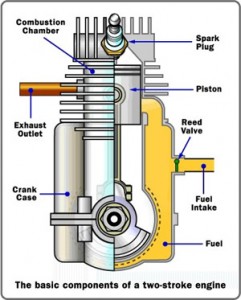Two-Stroke Engine Basics: Part Two
 Yesterday we overviewed some of the basics differences between four and two-stroke motors. Today we will go over some of the mechanical operations of the engine. A two-stroke engine is essentially a simplified version of the four-stroke, and this means that the cycle is more economical and many of the operations are consolidated. As we said previously, one of the biggest differences is that the spark plug fires once every revolution, as opposed to every other revolution.
Yesterday we overviewed some of the basics differences between four and two-stroke motors. Today we will go over some of the mechanical operations of the engine. A two-stroke engine is essentially a simplified version of the four-stroke, and this means that the cycle is more economical and many of the operations are consolidated. As we said previously, one of the biggest differences is that the spark plug fires once every revolution, as opposed to every other revolution.
The design of a two-stroke engine is designated as a “cross flow” and starts with the firing of the spark plug. The fuel and Evinrude XD100 mixture is combined with air and compressed. When the spark plug fires, it ignites that concoction and drives the piston of the engine. Once the piston hits its down stroke, the exhaust port is covered and the pressure drives the exhaust gases out. After the piston bottoms out, the intake port is covered and the mixture rushes into the cylinder, allowing the remaining exhaust gases to escape and fresh fuel to enter.


Comments